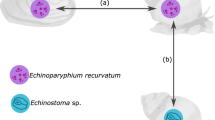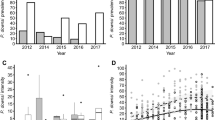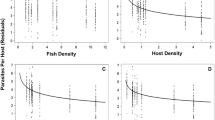Abstract
In nature, hosts are exposed to an assemblage of parasite species that collectively form a complex community within the host. To date, however, our understanding of how within-host–parasite communities assemble and interact remains limited. Using a larval amphibian host (Pacific chorus frog, Pseudacris regilla) and two common trematode parasites (Ribeiroia ondatrae and Echinostoma trivolvis), we experimentally examined how the sequence of host exposure influenced parasite interactions within hosts. While there was no evidence that the parasites interacted when hosts were exposed to both parasites simultaneously, we detected evidence of both intraspecific and interspecific competition when exposures were temporally staggered. However, the strength and outcome of these priority effects depended on the sequence of addition, even after accounting for the fact that parasites added early in host development were more likely to encyst compared to parasites added later. Ribeiroia infection success was reduced by 14 % when Echinostoma was added prior to Ribeiroia, whereas no such effect was noted for Echinostoma when Ribeiroia was added first. Using a novel fluorescent-labeling technique that allowed us to track Ribeiroia infections from different exposure events, we also discovered that, similar to the interspecific interactions, early encysting parasites reduced the encystment success of later arriving parasites by 41 %, which could be mediated by host immune responses and/or competition for space. These results suggest that parasite identity interacts with host immune responses to mediate parasite interactions within the host, such that priority effects may play an important role in structuring parasite communities within hosts. This knowledge can be used to assess host–parasite interactions within natural communities in which environmental conditions can lead to heterogeneity in the timing and composition of host exposure to parasites.



Similar content being viewed by others
References
Adamson ML, Noble SJ (1993) Interspecific and intraspecific competition among pinworms in the hindgut of Periplaneta americana. J Parasitol 79:50–56
Adamson ML, Buck A, Noble S (1992) Transmission pattern and intraspecific competition as determinants of population-structure in pinworms (Oxyurida, Nematoda). J Parasitol 78:420–426
Alford RA, Wilbur HM (1985) Priority effects in experimental pond communities: competition between Bufo and Rana. Ecology 66:1097–1105
Anderson RM, May RM (1978) Regulation and stability of host–parasite population’s interactions I–II. J Anim Ecol 47:219–247
Cattadori IM, Albert R, Boag B (2007) Variation in host susceptibility and infectiousness generated by coinfection: the myxoma-Trichostrongylus retortaeformis case in wild rabbits. J R Soc Interface 4:831–840
Cobey S, Lipsitch M (2013) Pathogen diversity and hidden regimes of apparent competition. Am Nat 181:12–24
Connell JH, Slatyer RO (1977) Mechanisms of succession in natural communities and their role in community stability and organization. Am Nat 111:1119–1141
Cox FEG (2001) Concomitant infections, parasites and immune responses. Parasitology 122:S23–S38
Cunningham ME, Markle DF, Watral VG, Kent ML, Curtis LR (2005) Patterns of fish deformities and their association with trematode cysts in the Willamette River, Oregon. Environ Biol Fishes 73:9–19
Duellman WE, Trueb L (1994) Biology of amphibians. John Hopkins University Press, Baltimore, Maryland
Fenton A (2008) Worms and germs: the population dynamic consequences of microparasite–macroparasite coinfection. Parasitology 135:1545–1560
Fenton A, Perkins SE (2010) Applying predator–prey theory to modelling immune-mediated, within-host interspecific parasite interactions. Parasitology 137:1027–1038
Gosner KL (1960) A simplified table for staging anuran embryos and larvae with notes and identification. Herpetologica 16:183–190
Graham AL (2008) Ecological rules governing helminth-microparasite coinfection. Proc Natl Acad Sci USA 105:566–570
Hamilton R, Siva-Jothy M, Boots M (2008) Two arms are better than one: parasite variation leads to combined inducible and constitutive innate immune responses. Proc R Soc Lond B 275:937–945
Hawley DM, Altizer SM (2010) Disease ecology meets ecological immunology: understanding the links between organismal immunity and infection dynamics in natural populations. Funct Ecol 25:48–60
Hawley DM, Altizer SM (2011) Disease ecology meets ecological immunology: understanding the links between organismal immunity and infection dynamics in natural populations. Funct Ecol 25:48–60
Holland MP (2009) Echinostome metacercariae cyst elimination in Rana clamitans (green frog) tadpoles is age-dependent. J Parasitol 95:281–285
Holland MP, Skelly DK, Kashgarian M, Bolden SR, Harrison LM, Cappello M (2007) Echinostome infection in green frogs (Rana clamitans) is stage and age-dependent. J Zool 271:455–462
Jackson JA, Pleass RJ, Cable J, Bradley JE, Tinsley RC (2006) Heterogenous interspecific interactions in a host–parasite system. Int J Parasitol 36:1341–1349
Johnson PTJ, Buller ID (2011) Parasite competition hidden by correlated coinfection: using surveys and experiments to understand parasite interactions. Ecology 92:535–541
Johnson PTJ, Hartson RB (2009) All hosts are not equal: explaining differential patterns of malformations in an amphibian community. J Anim Ecol 78:191–201
Johnson PTJ, Hoverman JT (2012) Parasite diversity and coinfection determine pathogen infection success and host fitness. Proc Natl Acad Sci USA 109:9006–9011
Johnson PTJ, McKenzie VJ (2008) Effects of environmental change on helminth infections in amphibians: exploring the emergence of Ribeiroia and Echinostoma infections in North America. In: Fried B, Toledo R (eds) The biology of echinostomes. Springer, New York
Johnson PTJ, Kellermanns E, Bowerman J (2011) Critical windows of disease risk: amphibian pathology driven by developmental changes in host resistance and tolerance. Funct Ecol 25:726–734
Johnson PTJ, Preston DL, Hoverman JT, Richgels KLD (2013) Biodiversity decreases disease through predictable changes in host community competence. Nature 494:230–233
Karvonen A, Seppala O, Valtonen ET (2009) Host immunization shapes interspecific associations in trematode parasites. J Anim Ecol 78:945–952
Keeney DB, Lagrue C, Bryan-Walker K, Khan N, Leung TLF, Poulin R (2008) The use of fluorescent fatty acid analogs as labels in trematode experimental infections. Exp Parasitol 120:15–20
Kelly DW, Thomas H, Thieltges DW, Poulin R, Tompkins DM (2010) Trematode infection causes malformations and population effects in a declining New Zealand fish. J Anim Ecol 79:445–452
Koprivnikar J, Marcogliese DJ, Rohr JR, Orlofske SA, Raffel TR, Johnson PTJ (2012) Macroparasite infections of amphibians: what can they tell us? EcoHealth 9:342–360
Lawler SP, Morin PJ (1993) Temporal overlap, competition, and priority effects in larval anurans. Ecology 74:174–182
Lello J, Norman RA, Boag B, Hudson PJ, Fenton A (2008) Pathogen interactions, population cycles, and phase shifts. Am Nat 171:176–182
Leung TLF, Poulin R (2011) Intra-host competition between coinfecting digeneans within a bivalve second intermediate host: dominance by priority-effect or taking advantage of others? Int J Parasitol 41:449–454
Lively CM (2009) Local host competition in the evolution of virulence. J Evol Biol 22:1268–1274
Menge BA, Sutherland JP (1987) Community regulation: variation in disturbance, competition, and predation in relation to environmental stress and recruitment. Am Nat 130:730–757
Mideo N (2009) Parasite adaptations to within-host competition. Trends Parasitol 25:261–268
Mideo N, Alizon S, Day T (2008) Linking within- and between-host dynamics in the evolutionary epidemiology of infectious diseases. Trends Ecol Evol 23:511–517
Pedersen AB, Fenton A (2007) Emphasizing the ecology in parasite community ecology. Trends Ecol Evol 22:133–139
Poulin R (2006) Global warming and temperature-mediated increases in cercarial emergence in trematode parasites. Parasitology 132:143–151
Poulin R (2007) Are there general laws in parasite ecology? Parasitology 134:763–776
R Development Core Team (2010) R: A language and environment for statistical computing. R Foundation for Statistical Computing, Vienna
Robinson JF, Dickerson JE (1987) Does invasion sequence affect community structure? Ecology 68:587–595
Rohr JR, Raffel TR, Hall CA (2010) Developmental variation in resistance and tolerance in a multi-host–parasite system. Funct Ecol 24:1110–1121
Schell SC (1985) Trematodes of North America North of Mexico. University of Idaho Press, Moscow
Schotthoefer AM, Koehler AV, Meteyer CU, Cole RA (2003) Influence of Ribeiroia ondatrae (Trematoda, Digenea) infection on limb development and survival of northern leopard frogs (Rana pipiens): effects of host stage and parasite-exposure level. Can J Zool 81:1144–1153
Smyth JD, Halton DW (1983) The physiology of trematodes, 2nd edn. Cambridge University Press, Cambridge
Sollid SA, Lorz HV, Stevens DG, Bartholomew JL (2003) Age-dependent susceptibility of chinook salmon to Myxobolus cerebralis and effects of sustained parasite challenges. J Aquat Anim Health 15:136–146
Sousa WP (1994) Patterns and processes in communities of helminth parasites. Trends Ecol Evol 9:52–57
Sutherland DR (2005) Parasites of North American frogs. In: Lannoo MJ (ed) Amphibian declines: the conservation status of United States species. University of California Press, Berkeley, pp 109–123
Tate AT, Rudolf VHW (2012) Impact of life stage specific immune priming on invertebrate disease dynamics. Oikos 121:1083–1092
Telfer S, Birtles R, Bennett M, Lambin X, Paterson S, Begon M (2008) Parasite interactions in natural populations: insights from longitudinal data. Parasitology 135:767–781
Telfer S, Lambin X, Birtles R, Beldomenico P, Burthe S, Paterson S, Begon M (2010) Species interactions in a parasite community drive infection risk in a wildlife population. Science 330:243–246
Thrall PH, Hochberg ME, Burdon JJ, Bever JD (2007) Coevolution of symbiotic mutualists and parasites in a community context. Trends Ecol Evol 22:120–126
Ulrich Y, Schmid-Hempel P (2012) Host modulation of parasite competition in multiple infections. Proc R Soc Lond B 279:2982–2989
Villeneuve DL, Curtis LR, Jenkins JJ, Warner KE, Tilton F, Kent ML, Watral VG, Cunningham ME, Markle DF, Sethajintanin D, Krissanakriangkrai O, Johnson ER, Grove R, Anderson KA (2005) Environmental stresses and skeletal deformities in fish from the Willamette River, Oregon. Environ Sci Technol 39:3495–3506
Werner EE, Peacor SD (2003) A review of trait-mediated indirect interactions in ecological communities. Ecology 84:1083–1100
Acknowledgments
We thank J. Bowerman K. Richgels, S. Paull, and D. Preston for providing animals for the experiments. We are indebted to M. Redmond and S. Todd for assistance with experimental maintenance and animal husbandry. We also thank B. LaFonte for guidance on parasite identification and animal dissections. This project was supported by a grant from NSF (DEB-0841758), a fellowship from the David and Lucile Packard Foundation and a RUBICON fellowship from the Netherlands Organization for Scientific Research (NWO; grant 825.11.036).
Author information
Authors and Affiliations
Corresponding author
Additional information
Communicated by Ross Alford.
Electronic supplementary material
Below is the link to the electronic supplementary material.
Rights and permissions
About this article
Cite this article
Hoverman, J.T., Hoye, B.J. & Johnson, P.T.J. Does timing matter? How priority effects influence the outcome of parasite interactions within hosts. Oecologia 173, 1471–1480 (2013). https://doi.org/10.1007/s00442-013-2692-x
Received:
Accepted:
Published:
Issue Date:
DOI: https://doi.org/10.1007/s00442-013-2692-x




